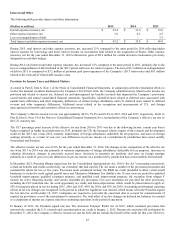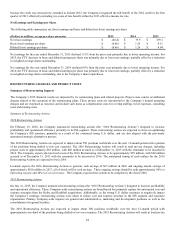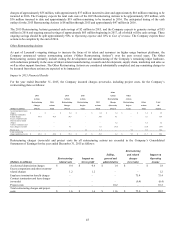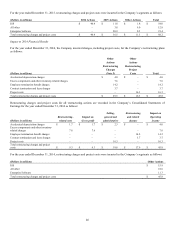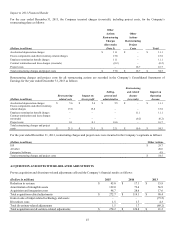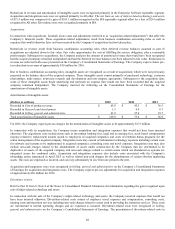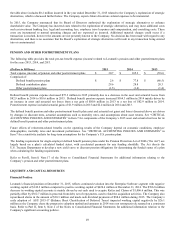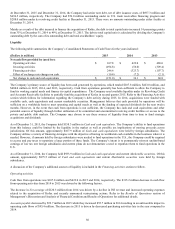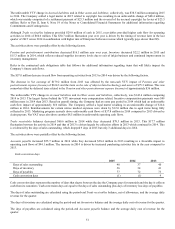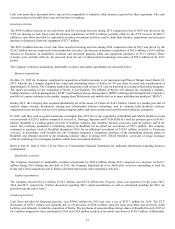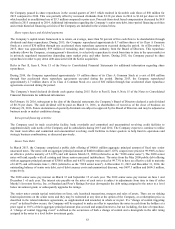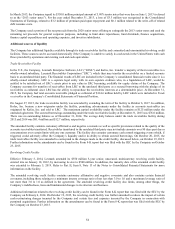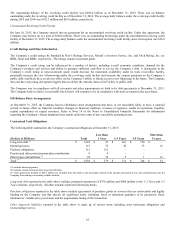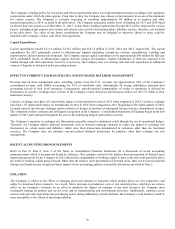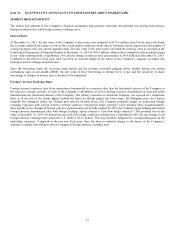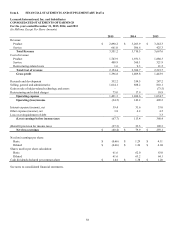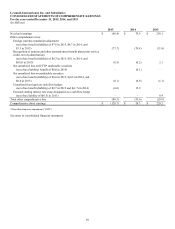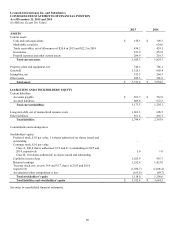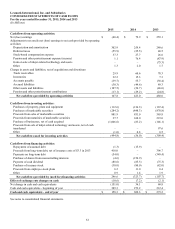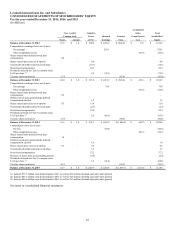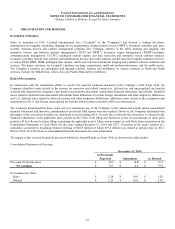Lexmark 2015 Annual Report Download - page 57
Download and view the complete annual report
Please find page 57 of the 2015 Lexmark annual report below. You can navigate through the pages in the report by either clicking on the pages listed below, or by using the keyword search tool below to find specific information within the annual report.53
the Company paused its share repurchases in the second quarter of 2015 which resulted in favorable cash flows of $50 million for
2015 compared to 2014. This was partially offset by increased dividends from $1.38 per share in 2014 to $1.44 per share in 2015
which resulted in an additional use of $3.3 million compared to prior year. Proceeds from stock based compensation decreased by $4.8
million in 2015 compared to 2014. Additional information regarding the Company’s senior note debt, intra-period financing activities
and certain historical financing activities of the Company are included in the sections below.
Share repurchases and dividend payments
The Company’s capital return framework is to return, on average, more than 50 percent of free cash flow to its shareholders through
dividends and share repurchases. During 2015, the Company repurchased approximately 0.7 million shares of its Class A Common
Stock at a cost of $30 million through one accelerated share repurchase agreement executed during the period. As of December 31,
2015, there was approximately $59 million of remaining share repurchase authority from the Board of Directors. This repurchase
authority allows the Company, at management’s discretion, to selectively repurchase its stock from time to time in the open market or
in privately negotiated transactions depending upon market price and other factors. During 2015, the Company paused its share
repurchases in order to pay down debt associated with the Kofax acquisition.
Refer to Part II, Item 8, Note 15 of the Notes to Consolidated Financial Statements for additional information regarding share
repurchases.
During 2014, the Company repurchased approximately 1.9 million shares of its Class A Common Stock at a cost of $80 million
through four accelerated share repurchase agreements executed during the period. During 2013, the Company repurchased
approximately 2.7 million shares of its Class A Common Stock at a cost of $82 million through four accelerated share repurchase
agreements executed during the period.
The Company’s board declared dividends each quarter during 2015. Refer to Part II, Item 8, Note 15 of the Notes to Consolidated
Financial Statements for additional information.
On February 18, 2016, subsequent to the date of the financial statements, the Company’s Board of Directors declared a cash dividend
of $0.36 per share. The cash dividend will be paid on March 11, 2016, to shareholders of record as of the close of business on
February 29, 2016. Future declarations of quarterly dividends are subject to approval by the Board of Directors and may be adjusted as
business needs or market conditions change.
Intra-period financing activities
The Company used its trade receivables facility, bank overdrafts and committed and uncommitted revolving credit facilities to
supplement daily cash needs of the Company and its subsidiaries during 2015 and 2014. The Company expects to continue to utilize
the trade receivables and committed and uncommitted revolving credit facilities in future quarters to help fund its operations and
strategic business combinations, as discussed previously.
Senior Note Debt
In March 2013, the Company completed a public debt offering of $400.0 million aggregate principal amount of fixed rate senior
unsecured notes. The notes with an aggregate principal amount of $400.0 million and 5.125% coupon were priced at 99.998% to have
an effective yield to maturity of 5.125% and will mature March 15, 2020 (referred to as the “2020 senior notes”). The 2020 senior
notes will rank equally with all existing and future senior unsecured indebtedness. The notes from the May 2008 public debt offering
with an aggregate principal amount of $300.0 million and 6.65% coupon were priced at 99.73% to have an effective yield to maturity
of 6.687% and will mature June 1, 2018 (referred to as the “2018 senior notes”). At December 31, 2015 and December 31, 2014, the
outstanding balance of senior note debt, net of debt issuance costs and unamortized discount, was $697.3 million and $696.5 million,
respectively.
The 2020 senior notes pay interest on March 15 and September 15 of each year. The 2018 senior notes pay interest on June 1 and
December 1 of each year. The interest rate payable on the notes of each series is subject to adjustments from time to time if either
Moody’s Investors Service, Inc. or Standard and Poor’s Ratings Services downgrades the debt rating assigned to the notes to a level
below investment grade, or subsequently upgrades the ratings.
The senior notes contain typical restrictions on liens, sale leaseback transactions, mergers and sales of assets. There are no sinking
fund requirements on the senior notes and they may be redeemed at any time at the option of the Company, at a redemption price as
described in the related indenture agreements, as supplemented and amended, in whole or in part. If a “change of control triggering
event” as defined below occurs, the Company will be required to make an offer to repurchase the notes in cash from the holders at a
price equal to 101% of their aggregate principal amount plus accrued and unpaid interest to, but not including, the date of repurchase.
A “change of control triggering event” is defined as the occurrence of both a change of control and a downgrade in the debt rating
assigned to the notes to a level below investment grade.


